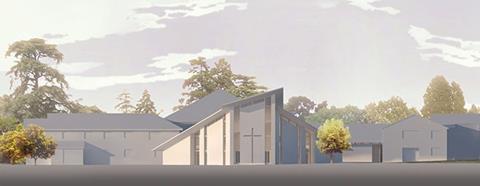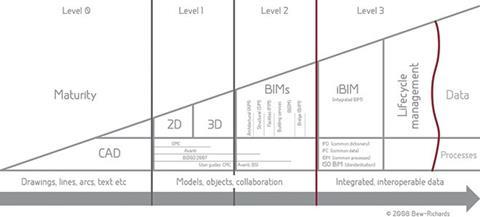As of 2016, all centrally procured government construction projects must implement level 2 BIM. Our latest CPD module, sponsored by Vectorworks, defines levels of BIM

How to take this module
UBM’s CPD distance-learning programme is open to anyone seeking to develop their knowledge and skills. Each module also offers members of professional institutions an opportunity to earn between 30 and 90 minutes of credits towards their annual CPD requirement.
This article is accredited by the CPD Certification Service. To earn CPD credits, read the article and then click the link below to complete your details and answer the questions. You will receive your results instantly, and if all the questions are correctly answered, you will be able to download your CPD certificate straight away.
CPD CREDITS: 60 MINUTES
DEADLINE: 10 OCTOBER 2014

WHAT IS BIM?
By 2016, all centrally procured government construction projects, no matter their size, must be delivered using BIM. There are two commonly accepted definitions:
BIM as a process
(�ڶ����� Information Modelling) is a business/process model for the design, analysis, execution, delivery and management of buildings by a highly collaborative, well-integrated project team, including designers, builders and owners. The process builds upon early design-phase contributions of team members’ expertise, guided by principles of trust, transparency, effective communication, open information sharing, team success tied to project success, shared risk and reward, value-based decision making, and the use of full technological capabilities and support. The outcome is the opportunity to execute “better, faster, cheaper” by reducing errors, waste and cost during the entire process.
BIM as data
(�ڶ����� Information Model) is the 3D geometry and extensive associated data, representing the necessary design, construction and facility management information. This data is generated by a wide variety of digital tools that address the different needs, abilities and responsibilities of the many stakeholders in the process. All the project data may be represented by one model or a federation of multiple domain models, with data that can be exchanged in whole or in part with other stakeholders at any time in the BIM process.
This CPD will focus on BIM as a process, and its first-time adoption by a small practice for a new-build project.

THE PRACTICE AND THE PROJECT
DUA Architecture has more than 25 years experience working primarily in Dorset and Hampshire, and has worked on a wide variety of projects. As a small practice (generally five staff members or less), it offers a personal service and has a policy of constantly exploring new technologies in both design and construction to improve speed, quality and service for clients.
DUA Architecture was appointed in June 2011 to work with the Moorlands College in Christchurch, which trains Christian ministers and missionaries. Over the last 65 years, it has produced some 3,000 graduates, more than 800 within the last 15 years. While Moorlands has grown numerically, the buildings and facilities have not kept pace and are in need of urgent renovation and extension. Its current building project will include a new community hub, reception area and conference facility, a multi-use centre providing two teaching spaces and a chapel area, which can be combined to provide a 350-seat lecture theatre. This case study will focus on the conference facility.
The practice had been using Vectorworks CAD software for many years. Having attended several seminars on BIM, the practice leaders decided to adopt the approach on the Moorlands College project. They had no formal BIM training but had completed the Vectorworks Architect tutorial manual which was written by expert trainer and architect Jonathan Pickup as part of Nemetschek Vectorworks’ self-paced training options. Essentially they learnt by doing.

DEVELOPING AN APPROACH TO BIM
The design was initially developed traditionally in 2D, with 3D modelling beginning post-planning. The practice felt that it would be beneficial to begin in 3D for future projects. The complex geometry of the building made the prospect of modelling it in 3D very attractive. They began with the steel frame and developed the model from there. The architect opted for a “lonely BIM” approach, in order to get themselves up to speed with the available modelling techniques and the process.
Lonely BIM refers to a process where models are created with no input from external consultants and are not shared throughout the project team. It is also referred to as level 1 implementation according to the widely used BIM maturity diagram, originally published by Mervyn Richards and Mark Bew in 2008 (see fig 1). This describes the stages that project teams will go through as they move from traditional processes and methods of drawing to implement fully open collaborative BIM.
The government’s 2016 target requires the implementation of level 2 BIM. This is where each discipline creates its own model and these are shared throughout the team, with all project data shared electronically as a common resource.
The eventual goal is level 3 BIM, a fully integrated, collaborative process, where models are shared on a web-enabled BIM hub, in a format compliant with an industry-wide open data standard. At this level, additional layers of data are also embedded in the model, including 4D construction sequencing and 5D cost.
Benefits of modelling with BIM
The practice found that modeling in detail was not overly time consuming but paid great dividends when cutting sections from the model, because a high level of detail is shown in the sections. They felt it was a more effective way of working, especially in handling the 3D geometry of the building.
One example is shown on drawing 1285.238 (fig 2). The design included quite complicated intersections between windows, walls, the steel frame and roof, and modelling enabled these to be refined at design stage and communicated to other consultants, client and contractor.
Meanwhile, for the roof, the practice is using a standard system but wanted to taper the verges and eaves. This required careful detailing with regards to supporting steel work, which they found was made easier in the model. In general, they found the model helped them to identify the areas that might be difficult much earlier and resolve any issues before reaching site.

Sunlight and shading analysis
The team also found BIM offered a great advantage when carrying out the sunlight and shading analysis. In the proposal design for the conference facility, there was a projector screen at the back of the stage. They wanted to make sure that bright sunlight from the high-level clerestory window would not fall on it at any time of the day throughout the year. They also wanted any shading solution to be “fit and forget”, which meant that accurate solar modelling was required.
Originally the design included a modestly sized screen, which would be viewable to only part of the audience, with other screens provided for the rest. By carrying out sunlight animations in the Renderworks software, the team found that this could be shaded by a few strategically placed “banners”, perpendicular to the windows. These banners could then feature artwork to complement the internal decor. However, as the project developed, the client requested that the screen at the back of the stage be made much larger, so traditional vertical blinds became the most practical way of shading it from the sun. The practice then used solar modelling to find the optimal angle at which the blinds should hang, thus maintaining the fit-and-forget nature of the solution.
Workgroup referencing
Inexperienced in the use of BIM, the team was working on one file. This rapidly became very large, and as the project progressed, it became necessary for multiple designers to be working on it at the same time. They therefore read up on the workgroup referencing feature within Vectorworks software. This can provide consistency and efficiency in project files, especially in a large organisation where a number of people are working on the same project.
Referencing allows drawing elements from one file to be used within another. When there is a change to a referenced item in the master file, this is reflected in the target file, and vice versa. Updates to target files can be performed either automatically or manually requested.
The workgroup feature allows the creation of a workgroup environment within which one or more folders of content files can be shared on a network. These files may contain content required by all users, such as templates, symbols, export settings or workspaces, or content specific to different projects. Communication among team members is essential when referencing and/or workgroups are in use.
The practice found that it took very little time to split the master file down into individual files, based on the previous file’s layer structure. They then referenced all files into a new master file called “complete”. They found this to be a very efficient way of working, because it enabled team members to work on different parts of the building at the same time, while another could set out drawings within the complete file.
Collaborative working with engineers
Though the team intentionally kept the BIM model in-house, they did provide elements of 3D information to the project engineers in the form of screen shots. They have found that the model made it easier to communicate issues and requests accurately, because they could very quickly cut the required section from the model, annotate and send to the relevant consultant (see Section JJ, fig 3) without attempting to describe it over the phone or producing potentially inaccurate sketches. On its next BIM project, the practice aims to export IFC models rather than images. This would allow the engineer to analyse and review 3D BIM models using free downloadable software such as Solibri Model Viewer.
Overall, the team found that their first experience of BIM gave them much greater confidence in the accuracy of their drawings, and facilitated greater speed and efficiency, and therefore productivity. It enabled them to spend less time preparing drawings and more time analysing designs and resolving issues, and also to produce a greater level of information with which to go out to tender.

How to take this module
UBM’s CPD distance-learning programme is open to anyone seeking to develop their knowledge and skills. Each module also offers members of professional institutions an opportunity to earn between 30 and 90 minutes of credits towards their annual CPD requirement.
This article is accredited by the CPD Certification Service. To earn CPD credits, read the article and then click the link below to complete your details and answer the questions. You will receive your results instantly, and if all the questions are correctly answered, you will be able to download your CPD certificate straight away.
CPD CREDITS: 60 MINUTES
DEADLINE: 10 OCTOBER 2014
Privacy policy
Information you supply to UBM Information Ltd may be used for publication and also to provide you with information about our products or services in the form of direct marketing by email, telephone, fax or post. Information may also be made available to third parties. UBM Information Ltd may send updates about �ڶ����� CPD and other relevant UBM products and services. By providing your email address you consent to being contacted by email by UBM Information Ltd or other third parties. If at any time you no longer wish to receive anything from UBM Information Ltd or to have your data made available to third parties, contact the Data Protection Coordinator, UBM Information Ltd, FREEPOST LON 15637, Tonbridge, TN9 1BR, Freephone 0800 279 0357 or email ubmidpa@ubm.com. View our full privacy policy at




















No comments yet